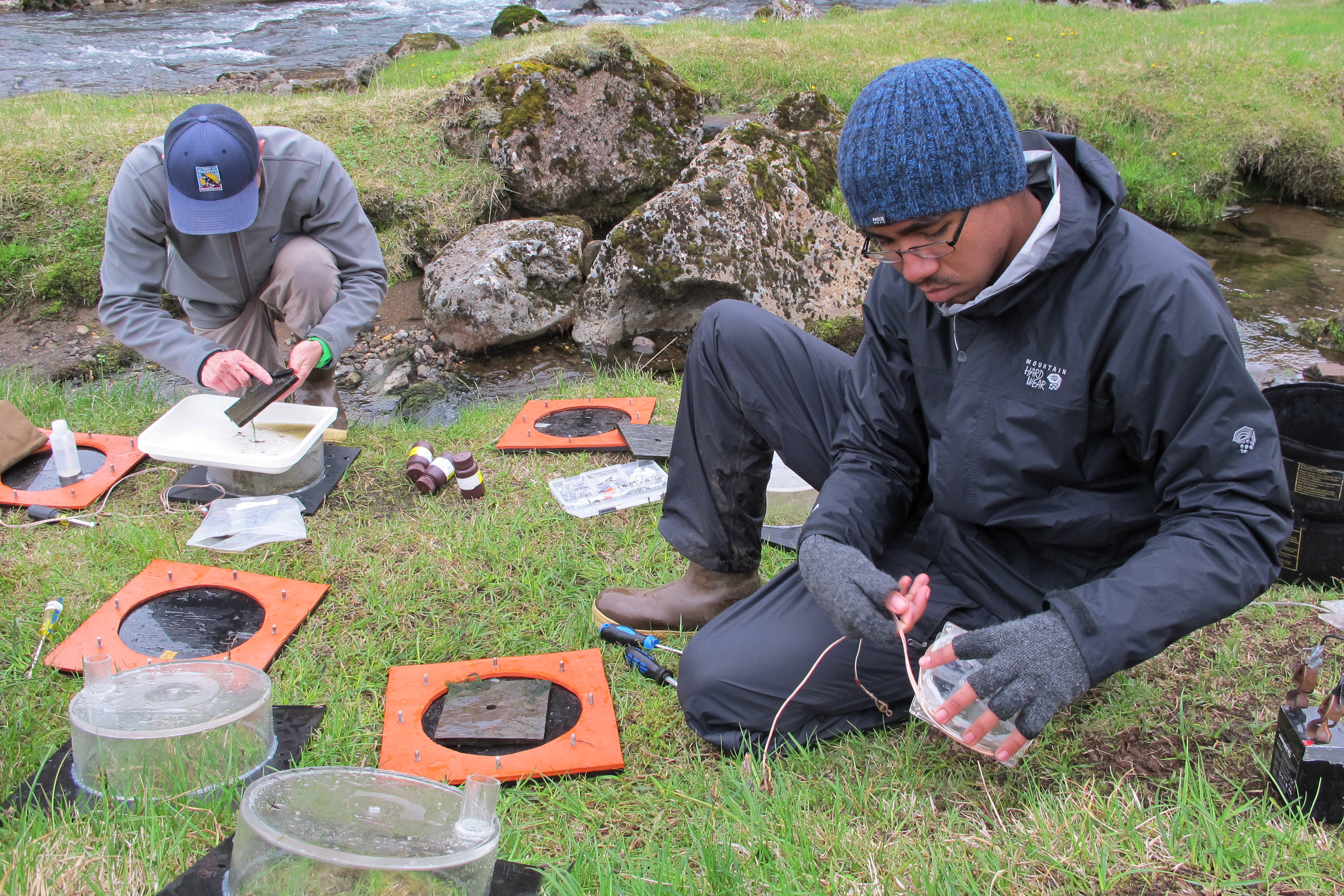By Chris Bryant and Adam Jones
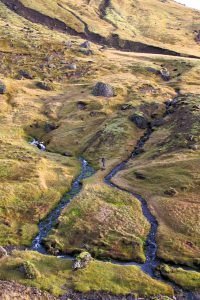
Heat, itself, is helping researchers discover potential impacts of a warming world.
Working along the slopes of a long-dormant volcano in Iceland, a group of scientists is taking advantage of the natural temperature variation in a set of freshwater streams to try and answer some serious “what if” questions.
What if the world’s average temperature increases between 3.5 and 4 degrees C. within the next century as some scientists predict? What impact could this have on freshwater environments?
Scientists, including a group from The University of Alabama, are turning the slopes of the Hengill volcano, in southwest Iceland, into a working laboratory.
The volcano, which hasn’t erupted in a few thousand years, lies several miles east of Reykjavik, Iceland’s capital. Its attraction for the researchers stems from the geothermal activity underneath it and the resulting warming on many of the streams flowing along its surface.
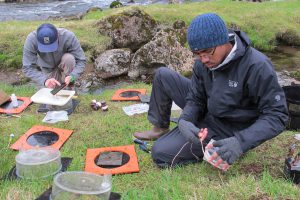
Iceland is the only exposed land mass where the Eurasian and North Atlantic tectonic plates meet. The gap between the plates is filled with molten rock. Because this magma is closer to the surface than in many parts of the world, it heats the water above it. It’s closer to the surface in some spots along Hengill than in others, resulting in a useful variation.
“You can work in a number of these different streams, and the water is at different temperatures, but it doesn’t have different chemical characteristics,” says Dr. Alex Huryn, an ecologist who directs UA’s Center for Freshwater Studies.
This is important as it creates one of the experiments’ needed variables – heat – without introducing others.
“The water does not come into contact with any molten lava, so it doesn’t become tainted with any weird chemical signatures,” Huryn says.
In some locations, you can find as much as a 20-degree temperature variation between two streams flowing less than three meters apart, says Dr. Jon Benstead, UA’s principal investigator in the project.
The research group, which includes representatives from Montana State University, St. Catherine University, University of Iceland and the Institute of Freshwater Fisheries in Iceland, focuses primarily on 13 streams ranging from 5 to 30 degrees C.
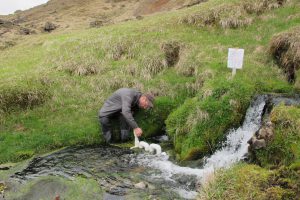
“One of the major problems with trying to predict the effects of climate change in real ecosystems,” says Huryn “is you have real-life constraints. You have systems that won’t follow theory, necessarily – not because the theory is wrong but because of idiosyncrasies of the particular system.”
These experiments, however, leave the petri dish, and some of the theory, back in the lab. They focus, instead, on actual streams.
Heating a real-world stream with a measure of control is a complicated task.
“You’re not just putting a kettle on a stove,” Huryn says.
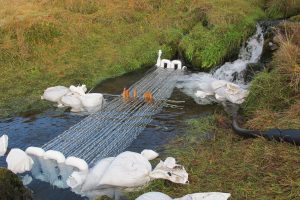
The biologists knew if the proper volume of water, at the appropriate temperatures and rates, could be diverted from a warmer stream into a cooler one, they could replicate, for example, the precise temperature increase predicted by climatologists. They could then study any impact on the environment.
So the biologists turned to Dr. Philip Johnson, a UA engineering faculty member, for help in solving what had now become an engineering problem.
“His weird ability to make things out of nothing is astonishing to us,” says Huryn of Johnson.
For one experiment, Johnson determined about 94,000 watts of energy — enough to produce water for 91 average-sized residential homes – was needed to heat one of the streams just 3 degrees. And, it was necessary to increase the stream’s temperature without pumps: Adding pumps would require solar arrays or fuel supplies and engines, increasing complexity, cost and the chance of failure.
A heat exchanger custom-built by Johnson was the solution. Heat exchangers, like the name suggests, are devices that transfer heat from a hot liquid to a cold one.
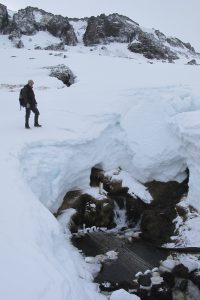
The team dammed one of the cold streams to create a pool for a pipe to take on water. Using gravity, the water ran down into a pool created by damming the hotter stream. The cool water zigzagged through pipes immersed in a warmer stream. This heated it to the desired temperatures before it flowed down an exit pipe back into the cool stream to heat it.
The calculations and custom-built heat exchanger did the job for the experiment, and it ran constantly through the summer and winter. Additional heat exchangers were designed for other experiments at the site.
“We have not used a smidgeon of fuel or electricity on these, and that’s pretty remarkable,” Johnson says. “It’s the most fun I had in years.”
For the biologists, the fun continues. Results from one of the series of experiments show that an increase in temperature increases the production of algae and, at a particular temperature point, the prevalence of green algae switches to a prevalence of so-called blue-green algae, or cyanobacteria.
Such changes, and others not yet understood, could prove significant, the researchers say, as they could have additional impacts higher up the food web.
Some bacteria, for example, are tastier than others, Benstead says.
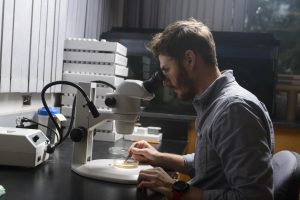
“Some of them are pretty good to eat, if you are an insect,” he says. “Others are not particularly palatable. If they are not very palatable, that means you’re now fixing all this carbon and fixing all this nitrogen into the system, and you are creating all this biomass, and it is not going anywhere. It is not going any higher up in the food web because nothing is eating it.”
Dan Nelson, a doctoral student working with the group, has already found, within the experimentally warmed stream, a decline in the abundance of larval midges, non-biting flies that live in and around the water. He also found a huge increase in the abundance of a particular species of blackfly and of freshwater snails.
“As we warm up,” Benstead says, “you are going to see the arrival and successful establishment of species anew. It’s difficult to predict exactly what is going to happen.”
The project, which continues through 2017, is funded by the National Science Foundation. UA’s portion of the NSF grants is $458,000. Benstead, an associate professor, and Huryn, a professor, are both part of the department of biological sciences within UA’s College of Arts and Sciences, while Johnson is an associate professor in the College of Engineering’s department of civil, construction and environmental engineering.
